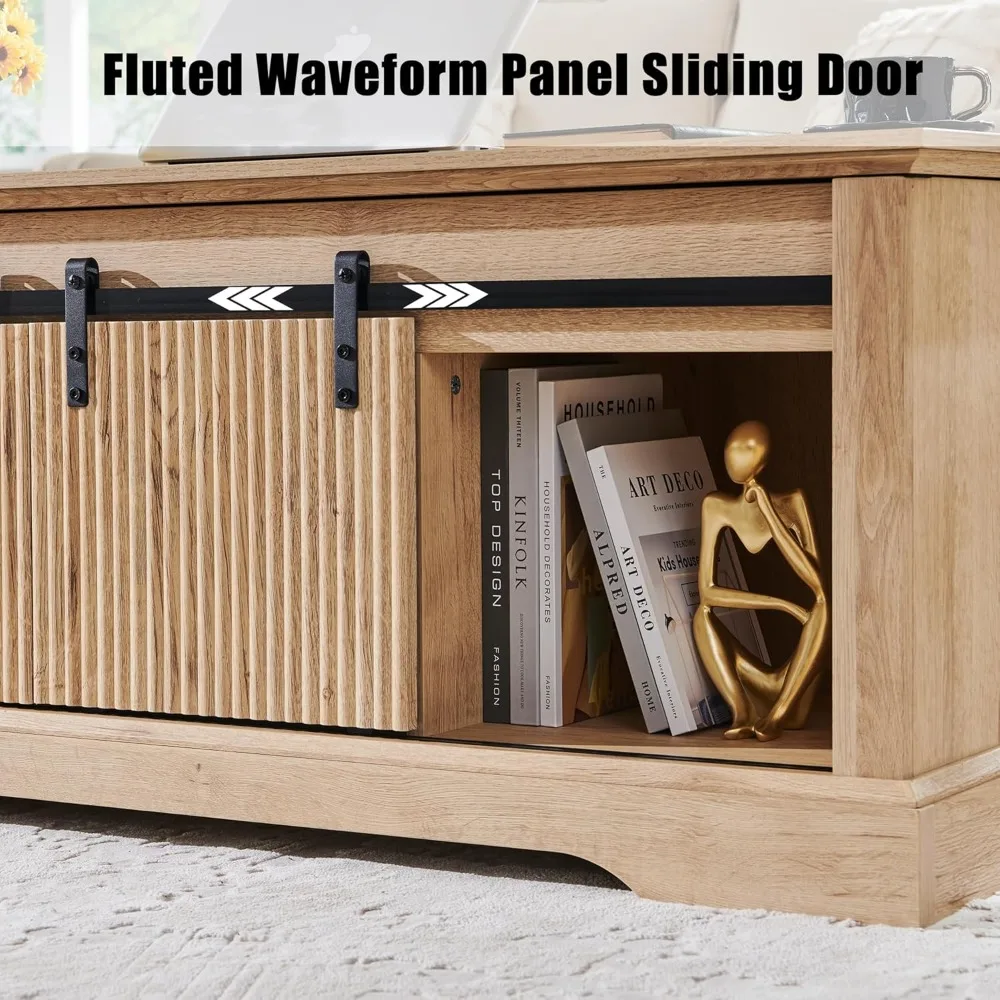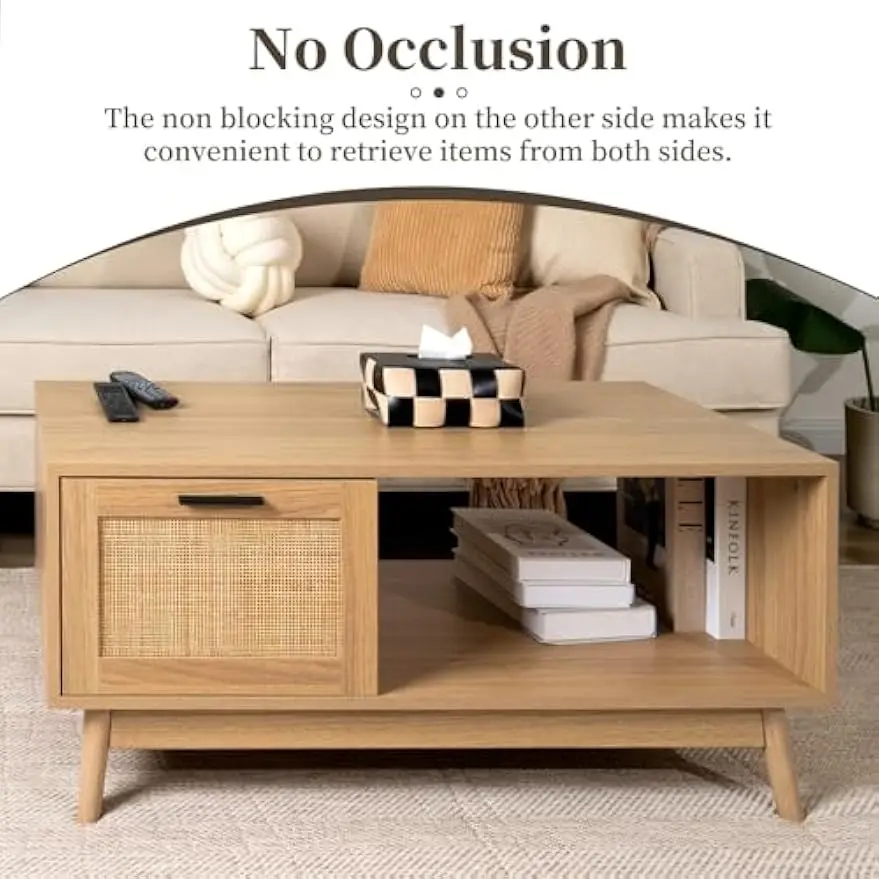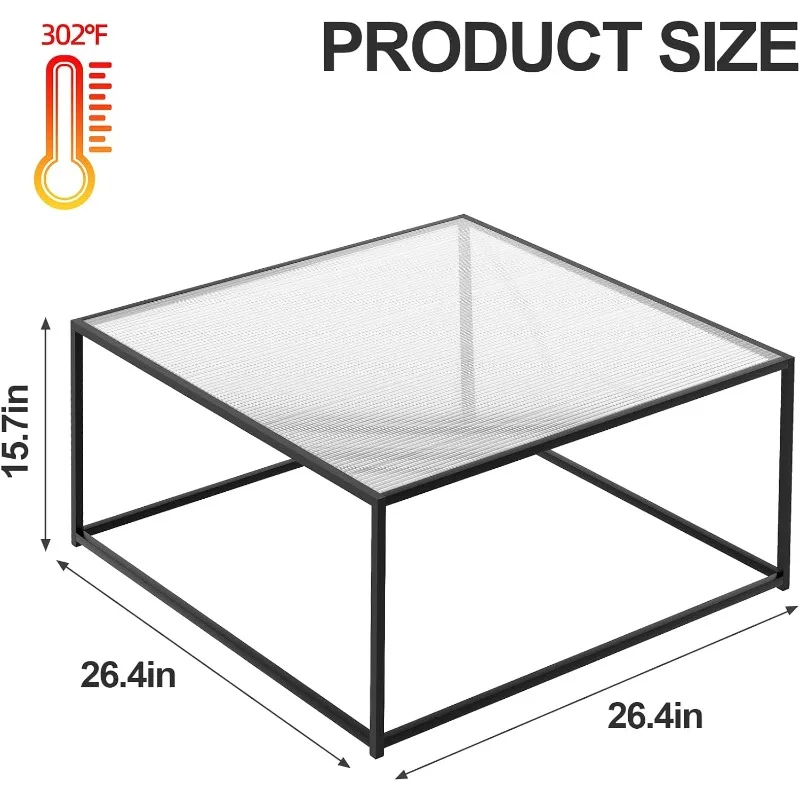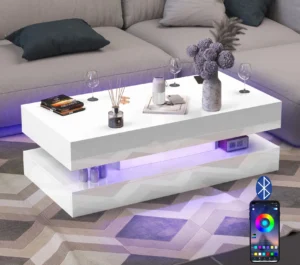The Rectangular Coffee Table: Your Living Room’s Centerpiece
The rectangular coffee table sits at the heart of most living rooms, commanding attention and serving as the anchor for your entire seating arrangement. Unlike their round or square counterparts, rectangular tables offer an extended surface area that presents unique styling opportunities and challenges. Their elongated shape naturally draws the eye and creates a sense of direction within your space.
What makes these tables special is their versatility. They not only provide a practical surface for everyday items but also serve as a canvas for personal expression. The distinctive proportions of a rectangular table allow for more elaborate styling arrangements while maintaining functionality. Understanding the rectangular coffee table design features helps create more intentional decorating decisions.
A thoughtfully styled coffee table does more than just look pretty—it transforms your entire living room’s atmosphere. When decorated with purpose, your table can reflect your personal taste while enhancing the room’s overall design cohesion. Throughout this guide, we’ll explore how to maximize both the beauty and function of your rectangular table, turning this everyday piece into a stunning focal point worthy of your mid-century modern rectangular coffee tables or any style you prefer.
Essential Design Principles for Rectangular Tables
Before diving into specific styling techniques, it’s important to understand the fundamental design principles that make rectangular coffee table styling successful. These principles will help you create arrangements that look intentional rather than random or cluttered.
Balance and Proportion
When working with rectangular surfaces, balance becomes crucial due to the elongated shape. The eye naturally travels across the length of the table, so visual weight must be thoughtfully distributed. There are two main approaches to balance:
Symmetrical balance creates a mirror effect, with similar objects placed on opposite sides of an imaginary center line. This approach feels formal, ordered, and classic—perfect for traditional or formal spaces. For example, matching table lamps or identical stacks of books on each end of your table creates this sense of symmetry.
Asymmetrical balance is more dynamic, using different objects that have equivalent visual weight. This approach feels more casual and contemporary. You might place a tall plant on one end and balance it with a stack of books and a lower, wider object on the other. Understanding how key design traits rectangular coffee tables affect your room can significantly impact your styling approach.
The size of your table in relation to your sofa is also important—ideally, your coffee table should be about two-thirds the length of your sofa for proper proportion. This relationship creates harmony in your transforming room layout rectangular coffee table arrangement.
Creating Visual Interest with Layers and Heights
One of the most common styling mistakes is placing all decorative items at the same height, creating a flat, uninteresting display. Instead, incorporate objects of varying heights to create dynamic visual interest across your rectangular surface.
Consider these height variations:
– Tall items (10-12 inches): statement vases, tall candlesticks, or sculptural pieces
– Medium items (6-8 inches): small potted plants, medium candles, or stacked books
– Low items (3-4 inches): trays, shallow bowls, or coffee table books lying flat
Layering is equally important on rectangular tables. Start with a base layer (like a tray or runner), add medium items, then finish with smaller decorative objects. This creates depth and visual complexity without appearing cluttered.
Always ensure decorative items don’t obstruct conversation—people should be able to see each other across the table without having to peek around tall objects. A good rule is to place taller items toward the ends or back of the table rather than in the center.
The Perfect Arrangement: Styling Approaches for Rectangular Tables
Once you understand the basic design principles, you can explore specific styling approaches that work particularly well for rectangular coffee tables. The elongated shape of these tables allows for more creative arrangement options than their square or round counterparts.
Different styling approaches work better for different table sizes. Longer, narrower tables may benefit from a linear arrangement that emphasizes their length, while wider rectangular tables might look best with clustered groupings. The difference between oval vs rectangular coffee tables affects how these styling techniques translate, so consider the specific proportions of your piece.
The Rule of Thirds Approach
The rule of thirds is a classic design principle that works exceptionally well for rectangular surfaces. Here’s how to apply it:
- Mentally divide your rectangular table into three equal sections horizontally
- Place a different grouping or type of decor in each section
- Ensure each section has its own focal point while maintaining overall balance
For example, on a standard rectangular coffee table:
– First third: Place a stack of 3-4 coffee table books with a small decorative object on top
– Middle third: Position a medium-sized tray with a candle and small decorative items
– Last third: Add a low, wide bowl or a small plant for organic texture
This approach creates natural movement across the table surface while maintaining balance. For longer tables, you might need to repeat patterns or create multiple groupings within each third to avoid sparse areas.
Focal Point and Supporting Elements Technique
Another effective approach is to establish a strong central focal point with supporting decorative elements arranged around it:
- Select one standout piece for the center of your table (a sculptural object, statement bowl, or dramatic floral arrangement)
- Arrange complementary items of varying heights around this focal point
- Create visual paths that lead the eye toward the central element
- Maintain negative space to prevent the arrangement from feeling crowded
For example, place a striking ceramic vase in the center of your table, then position stacked books on one side and a low tray with candles on the other. The height and visual interest of the central piece draws attention, while the supporting elements create context and balance. Understanding the styling differences between rectangular vs square coffee tables can help you better implement this technique.
Essential Decorative Elements for Rectangular Coffee Tables
Selecting the right decorative pieces is crucial for successful coffee table styling. Some elements work particularly well on rectangular surfaces, helping to enhance their proportions while creating visual interest.
When selecting decorative pieces, consider both aesthetics and function. The best coffee table styling incorporates items that reflect your personality while remaining practical for everyday use. Solid wood coffee tables provide a warm, natural foundation for styling that complements many decorative approaches.
Trays: The Foundation of Good Design
Trays are perhaps the most valuable styling tool for rectangular coffee tables. They serve multiple purposes:
- Define and organize space by creating a boundary for smaller objects
- Add a layer of texture and color to your arrangement
- Make it easy to move multiple decorative items at once when needed
- Protect the table surface from scratches, heat, or moisture
When selecting a tray for a rectangular table, consider its proportion to the table itself. Ideally, your tray should cover about one-third to one-half of the table surface, leaving room for other decorative elements. Rectangle or oval trays often work best as they echo and complement the table’s shape.
Material choice matters too. For mid-century modern tables, look for trays in warm wood tones, brass, or clean white lacquer. More traditional spaces might benefit from silver, gold, or richly textured materials. The tray should complement both your table material and your overall design aesthetic.
Books, Greenery, and Decorative Objects: Creating the Perfect Mix
The most visually appealing coffee table arrangements combine different elements to create texture, color, and personal meaning:
Coffee Table Books: These provide height, color, and personal interest. On rectangular tables, try:
– Creating two separate stacks at different heights
– Arranging books from largest to smallest in a single stack
– Placing some books flat and others standing with bookends for dimension
Plants and Flowers: Living elements add color and texture while softening hard surfaces:
– Low, wide planters work well on rectangular tables without blocking sightlines
– Small potted plants like succulents require little maintenance
– Fresh flowers in a simple vase create an elegant focal point
– Consider the scale—plants should be proportional to your table size
Decorative Objects: These personal items add character and dimension:
– Sculptural pieces create height and artistic interest
– Candles add warmth and can vary in height
– Bowls and vessels provide practical storage while adding shape
– Personal mementos make your space uniquely yours
For rectangular tables, try grouping objects in odd numbers (three or five items) for a more dynamic arrangement. Understanding specialized styling advice for glass top coffee tables can help when working with transparent surfaces.
Mid-Century Modern Styling for Rectangular Coffee Tables
The clean lines and organic forms of mid-century modern design pair beautifully with rectangular coffee tables. This iconic style emphasizes functionality, simplicity, and connection to nature—principles that translate perfectly to coffee table styling.
To achieve an authentic mid-century modern look on your rectangular coffee table:
Focus on materials that were popular during this era: walnut and teak woods, brass, glass, and ceramics in organic shapes. Incorporate pieces with tapered legs, atomic motifs, or sculptural forms that echo the design language of the period.
The color palette typically includes warm wood tones complemented by muted organic colors (olive green, burnt orange, mustard yellow) alongside neutral whites, blacks, and grays. Add pops of these colors through small decorative objects rather than overwhelming the space.
When styling a mid-century modern rectangular coffee table, embrace negative space. This design movement values clean lines and breathing room, so resist the urge to overcrowd. Instead, select fewer, more significant pieces that make a statement. Styling secrets rectangular mid-century tables can provide deeper insight into this aesthetic.
Glass-top coffee tables work exceptionally well with mid-century styling, as they maintain visual lightness while showcasing the architectural qualities of the table base.

Styling for Different Table Materials
The material of your coffee table significantly impacts styling decisions. Different surfaces interact with decorative objects in unique ways and may require special considerations:
Wood Tables: Warm and natural, wooden surfaces provide a rich backdrop for styling.
– Enhance rather than hide the natural grain by using placemats or runners instead of covering the entire surface
– Protect the finish by using coasters under drinks and trays under items that might scratch
– Complement the wood tone with ceramics, metals, and glass for textural contrast
– Consider the specific wood tone—walnut pairs beautifully with brass and rich colors, while lighter woods work well with silver tones and cooler hues
Glass Tables: Transparent surfaces create visual lightness but present unique challenges.
– Use placemats, runners, or trays to define spaces and prevent scratches
– Remember that objects appear to “float” and are visible from all angles, including underneath
– Be mindful of reflection and glare from items placed on glass
– Specialized advice for styling glass coffee tables can help navigate these considerations
Marble or Stone Tables: Luxurious but potentially delicate, these surfaces require thoughtful styling.
– Always use coasters and place mats to protect against stains and etching
– Complement the natural pattern with simple, solid-colored accessories
– Use felt-bottomed decorative objects to prevent scratches
– Let the beautiful material be the star by keeping styling somewhat minimal
Metal Tables: Modern and sleek, these provide a contemporary foundation.
– Add warmth through wood, textiles, and organic materials to balance the coolness of metal
– Use protective padding under objects to prevent scratches and noise
– Consider reflections and glare when positioning decorative objects
– Embrace the contemporary feel with geometric shapes and clean lines
Functionality and Style: The Perfect Balance
A beautifully styled coffee table still needs to function in daily life. Finding the balance between aesthetics and practicality ensures your table remains both beautiful and useful.
Consider how you actually use your coffee table. Do you need space for remote controls? Do you regularly place drinks or snacks on it? Do family members put up their feet? Understanding your habits helps create a styling approach that works with your lifestyle rather than against it.
Practical tips for maintaining functionality:
– Leave at least one-third of your table surface clear for everyday use
– Place frequently used items (like remotes) in decorative boxes or trays for easy access and quick cleanup
– Use stackable or nestable objects that can be rearranged as needed
– For families with young children, avoid fragile items or sharp edges
– Consider tables with storage features like lift-top coffee tables that provide hidden storage while maintaining style
When entertaining, you may need to temporarily modify your styling. Create a plan for quickly adjusting your arrangement to accommodate guests—perhaps moving a central vase to a side table or consolidating books to create space for drinks and appetizers.

Mid-Century Modern Solid Wood Coffee Tables, Mid-Century Modern Teak Coffee Tables
$879.95 Select options This product has multiple variants. The options may be chosen on the product pageMid-Century Modern Danish Coffee Tables, Mid-Century Modern Oval Coffee Tables, Mid-Century Modern Solid Wood Coffee Tables
$390.05 Select options This product has multiple variants. The options may be chosen on the product pageMid-Century Modern Glass Top Coffee Tables, Mid-Century Modern Glass Top Side & End Tables
$460.58 Select options This product has multiple variants. The options may be chosen on the product pageMid-Century Modern Glass Top Coffee Tables, Mid-Century Modern Vintage Coffee Tables, Mid-Century Modern Vintage Side & End Tables
$725.36 Select options This product has multiple variants. The options may be chosen on the product pageMid-Century Modern Lift Top Coffee Tables, Mid-Century Modern Square Coffee Tables
$454.73 Select options This product has multiple variants. The options may be chosen on the product pageMid-Century Modern Large Coffee Tables, Mid-Century Modern Rectangular Coffee Tables
$603.26 Select options This product has multiple variants. The options may be chosen on the product page
Seasonal and Occasional Updates
One of the joys of coffee table styling is the ability to refresh your look throughout the year. Seasonal updates keep your space feeling current and can reflect the changing energy of different times of year.
Simple seasonal adjustments might include:
Spring:
– Fresh flowers in light, bright colors
– Nature-inspired objects like bird figurines or nests
– Books with colorful covers or gardening themes
– Lighter, brighter candle scents
Summer:
– Coastal elements like shells or coral
– Blue and white ceramics for a fresh feel
– Botanical prints or tropical leaf arrangements
– Citrus or ocean-scented candles
Fall:
– Warmer metal tones like brass and copper
– Rich-colored books and objects
– Small bowls of pinecones or seasonal nuts
– Spice or wood-scented candles
Winter:
– Metallic accents for sparkle and light
– Cozy elements like small textured objects
– Deep green botanicals or evergreen sprigs
– Warm, spicy candle scents
For special occasions, consider temporary styling changes that enhance the event while maintaining your table’s basic structure. Holiday gatherings might call for festive elements, while dinner parties might require more open space for serving plates and glasses.
Walnut coffee tables provide a particularly versatile foundation for seasonal styling, as their warm tone complements virtually any color palette or seasonal theme.
Troubleshooting Common Rectangular Coffee Table Styling Challenges
Even with a good understanding of design principles, you may encounter specific challenges when styling rectangular coffee tables. Here are solutions to common issues:
Problem: Extra-long table looks sparse or disconnected
Solution: Create multiple vignettes connected by a runner or similar elements that guide the eye. Use larger statement pieces that match the table’s scale, and master space planning for long rectangular tables by dividing the surface into functional zones.
Problem: Narrow table limits styling options
Solution: Embrace a linear arrangement where items are positioned in a row rather than grouped. Choose narrower decorative objects, and consider using a narrow runner to define the space without overwhelming it.
Problem: Items slide on glass or slick surfaces
Solution: Use non-slip pads under trays and decorative objects. Textured placemats or runners can also provide grip while adding visual interest.
Problem: Lower shelf complicates the overall look
Solution: Style the lower shelf with larger, simpler items like stacked books, boxes, or baskets. Keep the color palette consistent between upper and lower surfaces for cohesion.
Problem: Off-center table makes styling feel unbalanced
Solution: Adjust your styling to account for the table’s position. Place taller items on the side closest to open space and lower items on the side nearest to furniture, creating visual balance despite the asymmetrical placement.
Problem: Table looks cluttered despite following guidelines
Solution: Scale back the number of separate items by grouping smaller objects on trays or books. Ensure you’re maintaining enough negative space—at least 30% of your table should remain visually “empty.”
Bringing It All Together: Three Complete Styling Examples
Let’s explore three distinct styling approaches for different rectangular coffee tables, showing how to apply the principles and techniques we’ve discussed.
Example 1: Minimalist Glass Table
For a sleek glass rectangular table in a contemporary space:
– Center a simple white rectangular tray (approximately 16” x 10”)
– Place three geometric concrete candle holders of varying heights (3”, 5”, and 7”) on one side of the tray
– Add a small stack of two art books with clean covers on the opposite side
– Include one small air plant in a simple concrete planter for organic texture
– Leave the remainder of the table clear to showcase the architectural base
This arrangement emphasizes negative space and clean lines while providing just enough visual interest. The transparent surface remains a feature rather than being completely covered.
Example 2: Traditional Wooden Rectangular Table
For a warm wooden table in a classic setting:
– Place a woven rectangular runner down the center of the table
– Position a medium-sized brass tray in the center containing a stack of three vintage books and a small potted fern
– Add a substantial wooden bowl at one end filled with textural objects like pine cones or wooden balls
– Place a pair of candlesticks of uneven heights (8” and 10”) at the opposite end
– Include a small decorative box for remotes or small items
This styling creates a rich, layered look that honors the table’s traditional character while maintaining functionality with the box for storage and clear areas at the edges.
Example 3: Family-Friendly Mid-Century Table
For a rectangular walnut table that needs to accommodate family activities:
– Use a low, wide tray on one half of the table to contain decorative items
– Within the tray, place a small stack of colorful coffee table books, a small ceramic vessel, and a wooden sculpture
– Leave the other half of the table entirely clear for everyday use
– On the lower shelf, use baskets to store games, remotes, and other frequently used items
– Select durable decorative objects that won’t break if accidentally knocked
This approach creates a styled look while acknowledging the practical needs of a family living space, demonstrating that function and beauty can coexist.
Styling Tips from Design Experts
Professional designers consistently emphasize certain principles when styling rectangular coffee tables. Their insights can help elevate your approach from basic to sophisticated.
Interior designers often recommend starting with a “hero piece”—one standout item that anchors your entire arrangement. This could be an unusual sculptural object, a statement bowl, or an oversized art book. Once this hero piece is positioned, other elements can be added around it to create context and balance.
Experts also stress the importance of editing. “When you think you’re finished, remove one item,” is common advice from design professionals. This practice ensures you’re not overcrowding your table and allows each piece to make an impact.
Professional stylists frequently mention the power of unexpected elements. Consider incorporating something surprising—perhaps an antique object in a modern space or a brightly colored item in an otherwise neutral palette. This creates visual interest and reflects personality.
Texture is another element that designers highlight as essential for successful coffee table styling. Combining different materials—smooth ceramics, rough natural elements, shiny metals, and soft textiles—creates depth and sensory appeal that elevates the entire arrangement.
Additional Resources to Perfect Your Coffee Table Style
To continue developing your coffee table styling skills and finding inspiration:
Design magazines remain valuable resources for studying professional styling. Pay attention to how rectangular tables are arranged in editorial photoshoots.
Social media platforms like Pinterest and Instagram offer endless inspiration for coffee table styling. Search specific hashtags like #coffeetablestyling or #rectangulartable for targeted ideas.
Local home décor stores often feature beautifully styled vignettes that can spark ideas. Take photos of arrangements you find appealing to reference later.
Thrift stores, flea markets, and antique shops are excellent sources for unique decorative objects that add character to your coffee table.
Online tutorials and styling videos can demonstrate techniques in real-time, showing exactly how to build layers and create balanced arrangements.
Remember that developing your styling eye takes practice. Don’t be afraid to experiment with different arrangements until you find what works best for your space, lifestyle, and personal taste. Coffee table styling should ultimately reflect who you are while enhancing the beauty and function of your living space.







